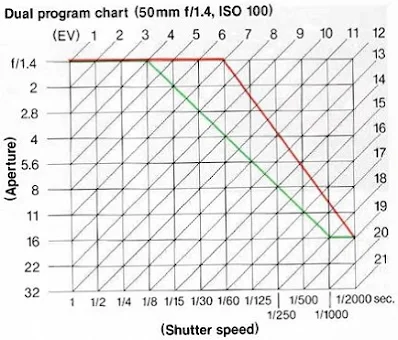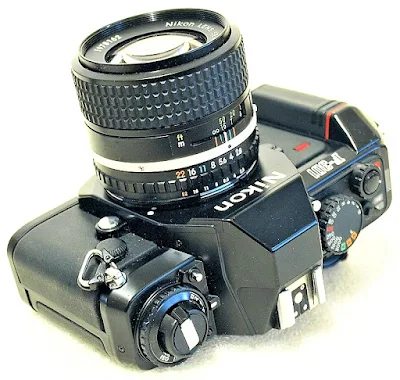I was looking down Nikon's 35mm SLR film camera production timeline and came to note that along with the likes of the Contax 167 MT (1986), the Nikon F-301 (N2000 in the US) is also a manual focus AE 35mm SLR film camera with a motorized film management system.
The F-301, a first for Nikon, was introduced as a replacement to the Nikon FG and comes with a polycarbonate body that has auto film loading and auto film advance features powered by a set of 4 AAA batteries. Launched in 1985, the camera is directly similar to the Nikon F501 (N2020 in the US), sans the autofocus feature.
The camera has a shutter speed range from 1 to 1/2000 second, a manual film speed range from ISO 12 to 3200 for non-DX coded film, or set automatically by the camera from ISO 25 to 4000 for DX-coded film. Metering is full-aperture center-weighted, with a metering range from EV1 to EV19 at IS0 100 with a 1.4 lens.
Nikon F-301 (N2000) Reviewed in 2017
I hope you enjoy my review of this classic 1980's film camera. Underated in my opinion. Update - I double checked and it's 2.5 frames per second on Continues mode. Not 5 frames per second as stated.
The F-301 does not come with a cable-release thread, depth-of-field preview, or dedicated mirror lockup, and operates at a noticeably high noise level when compared to its modern counterparts. Setting it apart, however, is a camera with robust mechanicals that seems to run on and on, and a design that heralds Nikon into the new generation of camera manufacturing.
It Is A Manual Focus AE SLR Film Camera
Just to reiterate here the Nikon F301 (N2000 in the US) is a manual focus AE 35mm SLR film camera with a motorized film management system.
A Note on Lens Compatability
It is worth noting that Nikkor pre-AI lenses do not have a notch in the aperture ring to engage the metering prong around the lens mount of the F-301. Such lenses will not mount on the F-301 and should not be used. These include:
- All Reflex-Nikkor lenses
- All PC-Nikkor lenses
- Bellows Attachment
- Extension Ring Set K
In addition, Medical-Nikkor lenses cannot be used in any auto-exposure mode.
Basic Camera Features
With a compact body that is 12.5mm wider than the Nikon FG, the F-301 has a body weight of 570 grams without batteries. It is a compact camera with features that make it comfortable in the hand, and easy and fun to use. Shutter actuation, mirror flap, and film advance, though not a thunderclap, might be a bit noisy to the user.
A simple front, from left to right, the finger grip, with the self-timer lamp and button located next to the lens mount housing, and to the right of the mount, the lens release button, and remote control terminal for use with the Nikon Remote Control Cord MC-12A.
The top plate is where all the controls and functionalities of the camera are located. On the outmost left are the integrated film rewind lever, the button release exposure compensation, and the pull-up and turn film ISO speed / DX-code selector. The film rewind lever itself is also the pull-up lever for the film back latch.
On the lower part below the dials mentioned above is a red indicator lamp that blinks when a shot is taken on non-DX-coded film when the DX contacts need cleaning, when the film roll is all used, and when the shutter is released.
On the right of the pentaprism hump that carries a flash hot-shoe, is the collection of buttons, dials, and slides that includes the shutter mode selector dial (with release button for A, P, P Hi mode selection); the shutter release button, power lock and the single of sequential shooting mode selector; audible warning switch; film release lever and button (for film rewinding); and film counter window.
On the back, below the top plate section which carries the viewfinder eyepiece, is a hinged film back with a film cartridge window, and a film advance indicator that rotates to show that the film is loaded and being advanced.
The four AAA batteries are loaded double abreast with opposite poles using a removable cradle that will fit back into the compartment at a specific orientation. Use the white dot guide marks and ridge extrusions within the battery compartment for a proper fit.
The film box is a standard Nikon Quick Load system where you need only to pull the film tab across the film frame and sprocket wheels to the red mark indicator before closing the back. Press the shutter button once to activate the film forward mechanism and the film will be forwarded to Frame 1.
Film Rewind and Unloading
Film rewind is manual. You need to slide the film rewind lever, located just behind the shutter speed dial, to the right, and press the film rewind button located next to it on the top plane before using the film rewind lever to spool the film back into the film canister.
Setting Film ISO Speed
The F-301 accepts both DX- and non-DX-coded films. For DX-coded films, pull the crown of the film ISO speed selector and turn it clockwise until the DX setting, or otherwise, turn it in the opposite direction for the non-DX ISO speed setting.
Exposure Modes
While saving from the use of a film forward lever and the ability to shoot continuously at 2.5 fps (frames per second), focusing on the MF F-301 is still fully manual.
AE (Automatic Exposure) reading can be set to Manual, Aperture-Priority, or to the Dual Program options - Program or Program Hi modes.
The Program mode is used in normal shooting conditions, while the Program Hi mode is the selection if you are after a higher speed range, such as in the situation of shooting fast-moving objects or while using telephoto lenses.
Viewfinder Readout
The viewfinder is a fixed eye-level pentaprism type with 92% field coverage. The focusing screen is a non-interchangeable Type K2 BriteView, with a central non-shading split-image rangefinder circle, microprism collar, and matte/Fresnel outer field.
Center-weighted exposure reading is taken off the outer 12mm diameter circle.
To the right of the viewfinder is a vertical bar with red numerals for shutter speed indication, over-, and underexposure warning LED, and flash-ready light when the camera is used with dedicated flash units. The red LEDs are not as bright as expected and may look washed out in bright light situations.
- Manual Mode - In fully manual mode, the sidebar will show a non-blinking LED to indicate the shutter speed set on the shutter speed dial, and the shutter speed for correct exposure will be indicated by a blinking LED. Two blinking LEDs indicate an intermediate shutter speed. No LED display is shown on the Bulb setting.
- Aperture Priority Mode - In Aperture Priority mode, the LED will show the shutter speed selected automatically by the camera. Over- and underexposure warning LED blinks will also be indicated, when applicable.
- P and P Hi Modes - In Program and Program Hi modes, the LED will display the shutter speed selected by the camera, the LED blinks for over- and underexposure indication, and for incorrect aperture settings,
Batteries
One of the delights of the F-301 is battery usage. Though the bottom plate of the camera can be replaced with an optional AA-type battery holder, the set of four easily available AAA batteries is already very adequate. As indicated in the N2000 instruction manual, a set of Alkaline-Manganese (LR03) batteries will power the camera up to 60 rolls of 36-exposure film rolls at normal operating temperatures (68°F).
The range is lower with NiCd (KR-AAA) batteries, which is up to 40 rolls, and lower still with Zinc-Carbon (UM-4) which will power up to 20 rolls of 36-exposure film rolls.
Using the Camera
Within the constraints of a manual focus 35mm SLR film camera, using the F-301 is easy and fun. Introduced as a replacement for the Nikon FG, the F-301 is best suited to the likes of the Nikon Series E lenses, which are compact, lightweight, and will not add much additional weight to the camera bag. These lenses are easily available at prices substantially below Nikon Nikkor originals.
You will do away with the need to remove the camera from your eye every time you need to advance the film, and for the super low prices that you can get for this camera, you will also get a motorized winder good enough for sports or other sequential shots you have always wanted to try hands-on.
Camera settings are no different from the AE manual focus SLR cameras that you have been using or learning how to use. You will have the option of shooting in full manual mode, aperture priority, or a choice of either the Program or Program Hi modes.
My experience with the camera also includes an episode, when I first got it, of a camera that has a very fuzzy and non-too-clear viewfinder. It was only later that I realized that the camera had been fitted with a diopter correction eyepiece that fits nice and snug, almost unnoticeable, over the original eyepiece. The viewfinder is now clear and super sharp.






















No comments:
Post a Comment